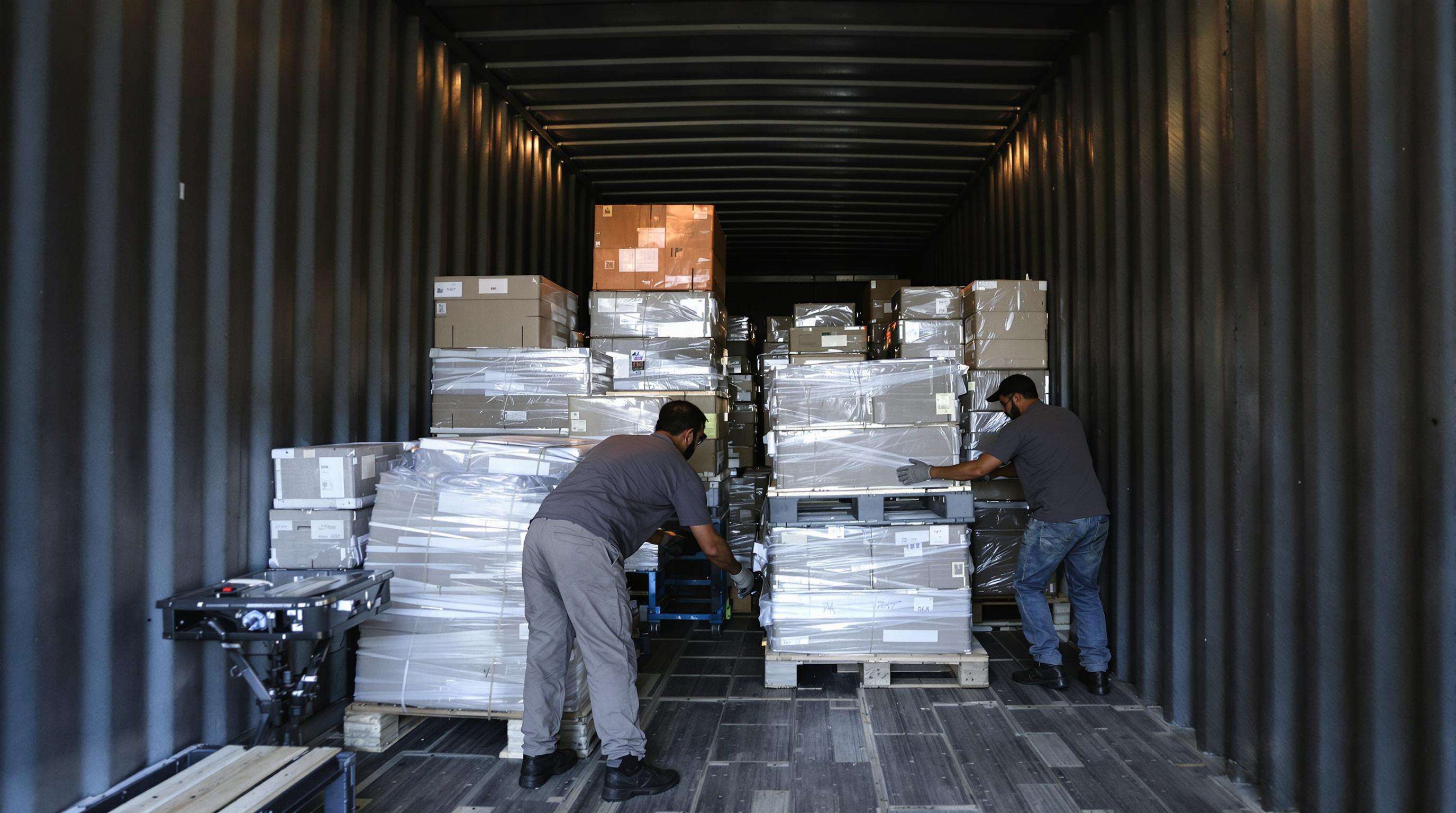News
Air Freight Consolidation Tips for Lower Carbon Footprint on Urgent Orders
Understanding Air Freight Consolidation and Its Environmental Benefits
While speed remains critical in urgent shipping, implementing strategic air freight consolidation tips can lower CO2 output by up to 20% per shipment (ICAO 2023). This approach combines multiple smaller shipments into optimized loads, balancing delivery urgency with sustainability.
What Is Air Freight Consolidation?
Air freight consolidation (also called groupage) merges cargo from multiple clients into a single aircraft shipment. Instead of dispatching partially filled planes for individual orders, logistics providers pool goods with matching destinations and timelines. For example, consolidating ten 500 kg shipments into one 5,000 kg load reduces aircraft deployments by 90%.
How Consolidation Lowers Carbon Emissions per Shipment
Every Boeing 747-8F flight generates 18,700 kg of CO2 per hour. By maximizing payload capacity, consolidation slashes emissions per kilogram shipped:
- Fuel efficiency: Fully loaded cargo planes emit 35% less CO2 per kg than partially filled ones (International Transport Forum 2022).
- Reduced takeoffs: A single consolidated flight replacing five partial shipments cuts 420 tons of CO2 annually on a high-demand route.
The Impact of Load Efficiency on Fuel Consumption and CO2 Output
According to the Aviation Environmental Report from 2021, planes actually consume around 12 to 18 percent less fuel when they're running at about 95% full compared to just 70%. When companies consolidate their cargo, they fill up those empty spaces in airplane cargo holds that otherwise go wasted. This matters quite a bit because what airlines charge for shipping stuff and how much pollution they create both depend heavily on how efficiently they pack things into available space. Research published last year showed something interesting too: every single ton mile traveled through consolidated shipments results in roughly 15 to 20% lower carbon emissions compared to regular shipping methods. So basically, good old fashioned smart packing not only helps cut down on greenhouse gases but doesn't hold anything up either.
Top Air Freight Consolidation Tips to Reduce Carbon Footprint Without Sacrificing Speed
Bundle Shipments with Matching Destinations and Delivery Windows
When airlines combine cargo going to similar places with close delivery windows, they end up with fewer half-empty planes and avoid extra trips altogether. According to research published last year in Inbound Logistics, businesses that group their packages together for areas where deliveries overlap can slash carbon emissions anywhere between 18% and 25%, instead of sending each item separately via air. Take medicines headed to Germany as just one case study. By putting all those boxes meant for Frankfurt and Amsterdam on the same plane, carriers not only reduce how often planes need to fly but still manage to get everything there within the required 48 hours. The math works out pretty well for everyone involved.
Optimize Packaging to Improve Cube Utilization

Maximizing cargo space efficiency reduces the number of containers or aircraft needed. Lightweight, modular packaging tailored to pallet dimensions can improve volumetric utilization by 15–20%, directly lowering fuel consumption per kilogram shipped. Nesting irregularly shaped items within standardized crates minimizes unused space without compromising delivery speed.
Partner with Carriers That Offer Green, Consolidated Networks
Collaborate with airlines and logistics providers prioritizing carbon-neutral consolidation programs. These networks pool shipments from multiple clients to fill cargo planes more efficiently, leveraging shared routes and sustainable aviation fuel (SAF) blends. Carriers with dedicated green networks often achieve 22–30% lower emissions per ton-mile than standard air freight operators.
Use Digital Freight Platforms for Real-Time Shipment Matching

Many cloud logistics systems now employ artificial intelligence to spot chances where shipments can be combined on the fly. According to some research shared on LinkedIn from the supply chain world, these smart matching systems cut down wasted cargo space by roughly 40 percent when handling rush orders. The software looks at all sorts of information as it comes in - weights, destinations, delivery windows - and figures out which packages make sense to group together automatically. This helps companies get products to market quickly while still making progress toward greener operations, something that used to feel like an either/or situation between fast delivery and environmental responsibility.
Measuring the Carbon Reduction Impact of Consolidated Air Cargo
Fuel Efficiency Gains from Higher Payload Utilization
Consolidating air freight shipments improves fuel efficiency by maximizing aircraft cargo space. A 2023 study in Transportation Research found filling planes to 95% capacity reduces fuel burn per kilogram by 18–22% compared to 70% utilization. This efficiency stems from fewer flights required to move equivalent cargo volumes, directly lowering CO2 emissions.
Case Study: 30% Lower CO2 Emissions After Consolidation by a Pharma Logistics Company
A leading pharmaceutical logistics provider achieved significant sustainability gains by reorganizing its emergency vaccine shipments. Over six months, consolidating 57% of previously direct flights into optimized routes reduced total emissions by 191 metric tons (–30%) while maintaining same-day delivery standards. The strategy eliminated 23 redundant flights monthly through improved destination clustering.
Comparative Analysis: Consolidated vs. Direct Air Freight Emissions
| Metric | Consolidated Shipments | Direct Shipments |
|---|---|---|
| CO2 per ton-mile | 6.8 kg | 9.2 kg |
| Aircraft utilization | 89–94% | 63–71% |
| Fuel waste | 3–5% | 12–18% |
Data shows consolidated air freight emits 26% less CO2 per ton-mile than direct shipments. This gap widens for urgent orders, where traditional methods often prioritize speed over load optimization—a practice responsible for 28% excess emissions in time-sensitive logistics (2024 Air Cargo Sustainability Report).
Overcoming Challenges in Sustainable Urgent Air Freight
Balancing Speed and Sustainability in Time-Sensitive Shipments
Air freight services that need to get packages fast tend to focus on speed rather than what's best for the environment. However, top logistics firms are starting to find ways around this problem using things like smart routing software and combining different shipment types. According to a recent industry report from 2023, about two thirds of shipping companies are being pushed hard to cut down their carbon footprint without sacrificing those super quick deliveries under two days. The situation is getting tricky because there just isn't enough green fuel available for planes yet, plus matching cargo loads in real time remains challenging for most operators. Many progressive businesses are tackling this issue through several approaches including...
- Assigning carbon budgets per shipment category
- Prioritizing SAF allocations for time-critical orders
- Using AI to identify consolidation-ready cargo without delaying core shipments
Addressing the Delay Paradox: Urgency vs. Consolidation Timing
A lot of people see a problem when trying to balance how fast things get consolidated with actual delivery dates, and this usually comes down to old school planning approaches that just don't work anymore. New digital systems have changed the game completely. They let companies consolidate stuff as it moves through the system based on what's happening right now with all the cargo. This has cut waiting periods dramatically most of the time. About three quarters of really time sensitive packages no longer sit around for days waiting to be grouped together. Instead they move much faster, often getting sorted within half a day or so. Take medicines that need special temperature control for instance. These days there are special routes set up specifically for them. Airlines charter planes ahead of time and pack several different customer loads onto these aircraft while making fuel stops along the way. This approach cuts carbon emissions by roughly one fifth compared to traditional methods, and best part is nobody misses their shipping window either.
Future Innovations in Green Air Freight and Smart Consolidation
AI-Powered Route and Load Optimization for Lower Emissions
AI technology is changing how air freight gets consolidated these days, mainly because of those smart algorithms that figure out how to fill planes better and cut down on wasted space. Some research from 2025 showed that when companies used AI to optimize loading, they actually saved around 15% on fuel costs for flights across continents. This happened because the system balanced all the cargo weights properly and picked good places to stop along the way. The AI also looks at things happening right now such as bad weather or busy airports to plan routes that produce fewer emissions. When there's something time sensitive to ship, these platforms will automatically sort similar deliveries together based on when they need to arrive. That's one reason why many logistics managers consider grouping compatible shipments as essential advice for keeping operations fast moving but still environmentally friendly.
The Role of Sustainable Aviation Fuels (SAF) in Consolidated Shipping
Mixing Sustainable Aviation Fuel with regular jet fuel might actually slash aviation emissions by around 30 percent if companies also adopt better flight consolidation practices. The thing is, SAF has about 12 percent more energy density compared to what planes normally burn, so this means aircraft can fly farther without needing to stop for fuel. That's especially handy for shipping companies that consolidate their cargo onto fewer planes on busy international routes. Right now, seventeen major airports worldwide have started setting up these SAF blending stations. For businesses concerned about their carbon footprint, this development opens doors to significantly lower emissions while moving goods across the globe. Some logistics firms are already seeing real benefits from switching part of their operations to SAF blends.
Regulatory Incentives Driving Low-Carbon Air Freight Consolidation
Starting from January 2026, new European Union rules require airlines flying out of member countries to use at least 10 percent Sustainable Aviation Fuel (SAF). Airlines that manage to get their load efficiency above 40 percent can actually claim some tax benefits as well. According to the International Air Transport Association (IATA), these kinds of regulations seem likely to push forward the shift towards more consolidated shipping approaches. By 2028, around two thirds of all air cargo might be going through these intelligent consolidation systems. Companies that have already started implementing both SAF and artificial intelligence based optimizations are seeing roughly a twenty two percent reduction in carbon related expenses per shipment when compared against traditional air freight operations, according to IATA's 2025 report.
FAQ
What is air freight consolidation?
Air freight consolidation is the process of combining multiple smaller shipments from different clients into one large shipment on a single aircraft. This helps in optimizing the load and reducing emissions per kilogram shipped.
How does air freight consolidation help reduce carbon emissions?
By maximizing aircraft payload capacity, air freight consolidation reduces the number of flights needed, thereby decreasing the carbon emissions per shipment. It enhances fuel efficiency and limits takeoffs, which significantly cuts CO2 output.
What are the challenges of sustainable urgent air freight?
The main challenges include balancing the speed of urgent deliveries with environmental sustainability, the availability of green fuels, and the real-time matching of cargo loads for efficient consolidation.
Recommended Products
Hot News
-
A Vital Freight Mode Connecting The World
2024-01-16
-
The Continued Development Of Our Freight Shipping Company
2024-01-16
-
The Importance Of A Trucking Company
2024-01-16

 EN
EN
 AR
AR
 FR
FR
 DE
DE
 PT
PT
 RU
RU
 ES
ES
 TR
TR
